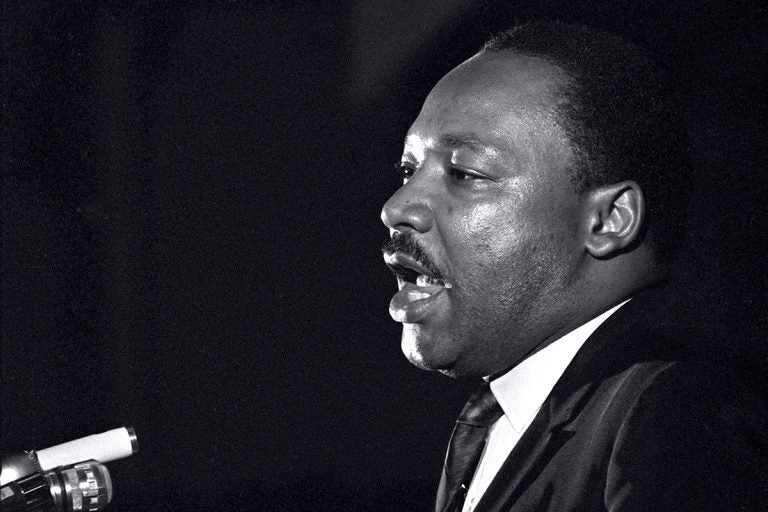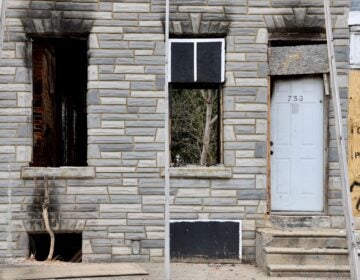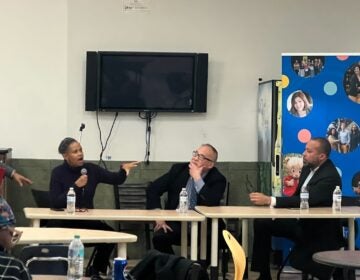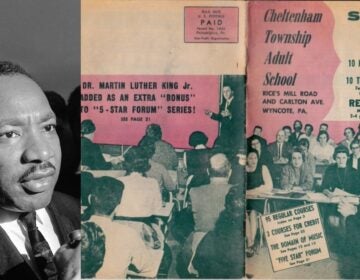‘Meeting physical force with soul force’: In King’s legacy, a guide to fight with words, images, and peace
Rev. David W. Brown reflects on Dr. Martin Luther King Jr., the media, and the Capitol riots.

Dr. Martin Luther King Jr. makes his last public appearance at the Mason Temple in Memphis, Tenn., on April 3, 1968. (AP Photo/Charles Kelly)
Dr. Martin Luther King Jr. understood that to affect change, he had to sway public opinion. On Monday, Jan. 18, WHYY and NewCORE will explore the late reverend’s strategic use of media to promote social change and suggest ways communities can craft narratives about themselves that advance their civic interest. This essay appears as part of that forthcoming dialogue. Register for the event here.
___
Armed rioters storming the U.S. Capitol. Police officers being beaten into retreat by the enraged mob. Property destroyed, offices defiled, and death. It was a scene on Jan. 6 that shocked the nation to its core.
Part of what made this tragedy so unsettling for me was that I — like many other Americans — have visited the sacred places that became ground zero for the carnage. I’ve walked on those Capitol steps and have stood in awe looking upwards at the Capitol’s dome. I’ve lingered in the Capitol hallways, hoping to convince an elected official with words, rather than threats of violence.
How appropriate it is that, only days removed from the violent scene at the Capitol, we reflect on Rev. Dr. Martin Luther King Jr., who expertly used the backdrop of Washington, D.C., as a powerful platform to promote peace.
Dr. King strove to build bridges through his words and deeds. He’s remembered largely for his pursuit of unity, and rightfully so. But an equal part of Dr. King’s legacy was his ability to leverage the news media to advance the cause of justice.
Consider Bloody Sunday when, in 1965, peaceful protesters were physically beaten back across the Edmund Pettus Bridge in Selma, Alabama. How would that story have been told had the cameras not been rolling?
What about the violence against the brave souls sitting at the “White Only” counters in segregated cities throughout the South. And for Dr. King, might we have never heard his dream had it not been delivered in the gleam of the Lincoln Memorial?
These sights and sounds formed the narrative for the civil rights movement. They motivated millions of Americans to act. They helped pass legislation. And they inspired the battle cry of “Black Lives Matter,” which today is shouted in streets across the country. It makes you wonder: What script will emerge from the siege of the Capitol? Insurrection? Sedition? Civil War? The answer depends on us.
No doubt that when Dr. King uttered those words of hope to “let freedom ring,” he had no delusions about how hard the fight would be to make that dream a reality. And those of us who continue to fight the good fight know that the battle is long, arduous, and sometimes dangerous.
But the struggle never meant that the freedom of one should come at the expense of another. When that becomes the rule, we degenerate into the kind of nation divided that sees the world as Us vs. Them; Black vs. White; Anybody vs. Everybody Else.
After 400 years of being kept from equal access to that guarantee of life, liberty, and the pursuit of happiness, you have almost no choice but to see life from the outside hoping to be let in. And once you get to the precipice, the temptation to kick in the door and exact revenge on those who’ve kept you out so long is hard to resist.
Despite his stature, Dr. King was still one of the millions of Black people struggling for their own civil rights, while fighting for the rights of others. But instead of lighting a fuse as he stood before the throngs of people who had gathered in the sweltering August sun in 1963 to march on Washington, he shed a different kind of light.
“(There) is something that I must say to my people who stand on the warm threshold which leads into the palace of justice,” King said on that historic day. “In the process of gaining our rightful place we must not be guilty of wrongful deeds. Let us not seek to satisfy our thirst for freedom by drinking from the cup of bitterness and hatred. We must forever conduct our struggle on the high plane of dignity and discipline. We must not allow our creative protest to degenerate into physical violence. Again and again we must rise to the majestic heights of meeting physical force with soul force.”
Rising to majestic heights and meeting physical force with soul force is the kind of climb that can lift us all.
___
The Rev. David W. Brown is the diversity advisor to the Office of the Dean at Klein College of Media and Communication and an executive committee member of NewCORE (the New Conversation on Race and Ethnicity).
WHYY is your source for fact-based, in-depth journalism and information. As a nonprofit organization, we rely on financial support from readers like you. Please give today.




